Vapor Deposition Growth of SiC Crystal on 4H-SiC Substrate by Molecular Dynamics Simulation
Abstract
:1. Introduction
2. Method
2.1. Interatomic Potential of the Atomistic Models
2.2. Atomistic Models and Simulation Procedure
2.3. Methods for Characterization of Crystal Structure and Defects
3. Results
3.1. The Atomistic Structure and Polytypes of SiC Formed in the Deposited Films
3.2. Dislocation Analysis
4. Discussion
4.1. Kinetic Features of Nucleation and Growth of Crystals in Vapor Deposition Process
4.2. Mechanism of Dislocation Formation
5. Conclusions
Supplementary Materials
Author Contributions
Funding
Data Availability Statement
Acknowledgments
Conflicts of Interest
References
- Kimoto, T. Bulk and epitaxial growth of silicon carbide. Prog. Cryst. Growth Charact. Mater. 2016, 62, 329–351. [Google Scholar] [CrossRef]
- Chaussende, D.; Wellmann, P.J.; Pons, M. Status of SiC bulk growth processes. J. Phys. D Appl. Phys. 2007, 40, 6150–6158. [Google Scholar] [CrossRef]
- Matsunami, H.; Kimoto, T. Step-controlled epitaxial growth of SiC: High quality homoepitaxy. Mater. Sci. Eng. R Rep. 1997, 20, 125–166. [Google Scholar] [CrossRef]
- Song, B.; Gao, B.; Han, P.; Yu, Y.; Tang, X. Numerical Simulation of Gas Phase Reaction for Epitaxial Chemical Vapor Deposition of Silicon Carbide by Methyltrichlorosilane in Horizontal Hot-Wall Reactor. Materials 2021, 14, 7532. [Google Scholar] [CrossRef] [PubMed]
- Sumakeris, J.J.; Leonard, R.T.; Deyneka, E.; Khlebnikov, Y. Dislocation Characterization in 4H-SiC Crystals. Mater. Sci. Forum 2016, 858, 393–396. [Google Scholar] [CrossRef]
- Nakano, T.; Shinagawa, N.; Yabu, M.; Ohtani, N. Formation and multiplication of basal plane dislocations during physical vapor transport growth of 4H-SiC crystals. J. Cryst. Growth 2019, 516, 51–56. [Google Scholar] [CrossRef]
- Xu, M.; Girish, Y.R.; Rakesh, K.P. Recent advances and challenges in silicon carbide (SiC) ceramic nanoarchitectures and their applications. Mater. Today Commun. 2021, 28, 102533. [Google Scholar] [CrossRef]
- Meng, B.; Qiu, P.; Yuan, D.; Xu, S. Influence of microstructure on the diamond-machinability of hot-pressed silicon carbide: A molecular dynamics study. Ceram. Int. 2019, 45, 22872–22879. [Google Scholar] [CrossRef]
- Semmelroth, K.; Krieger, M.; Pensl, G.; Nagasawa, H. Growth of cubic SiC single crystals by the physical vapor transport technique. J. Cryst. Growth 2007, 308, 241–246. [Google Scholar] [CrossRef]
- Seki, K.; Alexander, S.; Kozawa, S. Polytype-selective growth of SiC by supersaturation control in solution growth. J. Cryst. Growth 2012, 360, 176–180. [Google Scholar] [CrossRef]
- Inomata, Y.; Inoue, Z.; Mitomo, M.; Suzuki, H. Relation Between Growth Temperature and the Structure of SiC Crystals Grown by the Sublimation Method. J. Ceram. Assoc. Jpn. 1968, 76, 313–319. [Google Scholar] [CrossRef]
- Chen, X.; Zhao, H.; Ai, W. Study on the competitive growth mechanism of SiC polytypes using Kinetic Monte Carlo method. J. Cryst. Growth 2021, 559, 126042. [Google Scholar] [CrossRef]
- Yang, Y.B.; Wang, J.; Wang, Y.M. Thermal stress simulation of optimized SiC single crystal growth crucible structure. J. Cryst. Growth 2018, 504, 31–36. [Google Scholar] [CrossRef]
- Samant, A.V.; Pirouz, P. Activation parameters for dislocation glide in α-SiC. Int. J. Refract. Metals Hard Mater. 1998, 16, 277–289. [Google Scholar] [CrossRef]
- Selder, M.; Kadinski, L.; Durst, F.; Hofmann, D. Global modeling of the SiC sublimation growth process: Prediction of thermoelastic stress and control of growth conditions. J. Cryst. Growth 2001, 226, 501–510. [Google Scholar] [CrossRef]
- Steiner, J.; Arzig, M.; Denisov, A.; Wellmann, P.J. Impact of Varying Parameters on the Temperature Gradients in 100 mm Silicon Carbide Bulk Growth in a Computer Simulation Validated by Experimental Results. Cryst. Res. Technol. 2020, 55, 1900121. [Google Scholar] [CrossRef]
- Wellmann, P.J. Review of SiC crystal growth technology. Semicond. Sci. Technol. 2018, 33, 103001. [Google Scholar] [CrossRef]
- Xue, L.; Feng, G.; Wu, G.; Wang, S.; Li, R.; Han, X.; Sun, Y.; Liu, S. Study of the deposition of nanopillar-patterned 4H-SiC by molecular dynamics simulation. Appl. Surf. Sci. 2022, 579, 152209. [Google Scholar] [CrossRef]
- Liu, B.; Yu, Y.; Tang, X.; Gao, B. Influence of silicon melt convection on interface instability in large-size silicon carbide solution growth. J. Cryst. Growth 2019, 527, 125248. [Google Scholar] [CrossRef]
- Kang, K.-H.; Eun, T.; Jun, M.-C.; Lee, B.-J. Governing factors for the formation of 4H or 6H-SiC polytype during SiC crystal growth: An atomistic computational approach. J. Cryst. Growth 2014, 389, 120–133. [Google Scholar] [CrossRef]
- Vashishta, P.; Kalia, R.K.; Nakano, A.; Rino, J.P. Interaction potential for silicon carbide: A molecular dynamics study of elastic constants and vibrational density of states for crystalline and amorphous silicon carbide. J. Appl. Phys. 2007, 101, 103515. [Google Scholar] [CrossRef]
- Tersoff, J. Modeling solid-state chemistry: Interatomic potentials for multicomponent systems. Phys. Rev. B 1989, 39, 5566–5568. [Google Scholar] [CrossRef]
- Jiang, C.; Morgan, D.; Szlufarska, I. Carbon tri-interstitial defect: A model for the DII center. Phys. Rev. B 2012, 86, 144118. [Google Scholar] [CrossRef]
- Plimpton, S. Fast Parallel Algorithms for Short-Range Molecular Dynamics. J. Comput. Phys 1995, 117, 1–19. [Google Scholar] [CrossRef]
- Parrinello, M.; Rahman, A. Crystal Structure and Pair Potentials: A Molecular-Dynamics Study. Phys. Rev. Lett. 1980, 45, 1196–1199. [Google Scholar] [CrossRef]
- Nose, S. A Unified Formulation of the Constant Temperature Molecular-Dynamics Methods. J. Chem. Phys. 1984, 81, 511–519. [Google Scholar] [CrossRef]
- Nose, S. A molecular dynamics method for simulations in the canonical ensemble. Mol. Phys. 1984, 52, 255–268. [Google Scholar] [CrossRef]
- Hoover, W.G. Canonical dynamics: Equilibrium phase-space distributions. Phys. Rev. A 1985, 31, 1695–1697. [Google Scholar] [CrossRef] [PubMed]
- Stukowski, A. Visualization and analysis of atomistic simulation data with OVITO—The Open Visualization Tool. Modell. Simul. Mater. Sci. Eng. 2010, 18, 015012. [Google Scholar] [CrossRef]
- Maras, E.; Trushin, O.; Stukowski, A.; Ala-Nissila, T.; Jónsson, H. Global transition path search for dislocation formation in Ge on Si(001). Comput. Phys. Commun. 2016, 205, 13–21. [Google Scholar] [CrossRef]
- Stukowski, A.; Albe, K. Extracting dislocations and non-dislocation crystal defects from atomistic simulation data. Modell. Simul. Mater. Sci. Eng. 2010, 18, 085001. [Google Scholar] [CrossRef]
- Gruber, J.; Zhou, X.W.; Jones, R.E.; Lee, S.R.; Tucker, G.J. Molecular dynamics studies of defect formation during heteroepitaxial growth of InGaN alloys on (0001) GaN surfaces. J. Appl. Phys. 2017, 121, 195301. [Google Scholar] [CrossRef]
- Gruber, K.J.; Zhou, X.W.; Jones, R.E.; Lee, S.R.; Tucker, G.J. Molecular dynamics studies of InGaN growth on nonpolar (11–20) GaN surfaces. Phys. Rev. Mater. 2018, 2, 013402. [Google Scholar] [CrossRef]
- Zhang, L.; Li, L.; Wang, Y.; Suo, Y.; Liu, S.; Gan, Z. Atomic simulation of AlGaN film deposition on AlN template. Mol. Phys. 2019, 118, 1702728. [Google Scholar] [CrossRef]
- Wang, B.; Yin, J.; Chen, D.; Long, X. Optical and surface properties of 3C–SiC thin epitaxial films grown at different temperatures on 4H–SiC substrates. Superlattices Microstruct. 2021, 156, 106960. [Google Scholar] [CrossRef]
- Takahashi, N.O.J. Modified-Lely SiC Crystals Grownin [1-100] and [11-20] Directions. Phys. Status Solidi (b) 1997, 202, 163–175. [Google Scholar] [CrossRef]
- Jepps, N.W.; Page, T.F. Polytypic transformations in silicon carbide. Prog. Cryst. Growth Charact. Mater. 1983, 7, 259–307. [Google Scholar] [CrossRef]
- Yoo, W.S.; Matsunami, H. Solid-State Phase Transformation in Cubic Silicon Carbide. Jpn. J. Appl. Phys. 1991, 30, 545. [Google Scholar] [CrossRef]
- Shi, Y.; Jokubavicius, V.; Höjer, P. A comparative study of high-quality C-face and Si-face 3C-SiC(1 1 1) grown on off-oriented 4H-SiC substrates. J. Phys. D Appl. Phys. 2019, 52, 345103. [Google Scholar] [CrossRef]
- Hoshino, N.; Kamata, I.; Kanda, T.; Tokuda, Y.; Kuno, H. Reduction in dislocation densities in 4H-SiC bulk crystal grown at high growth rate by high-temperature gas-source method. Appl. Phys. Express. 2020, 13, 095502. [Google Scholar] [CrossRef]
- Sakwe, S.A.; Stockmeier, M.; Hens, P.; Müller, R. Bulk growth of SiC—Review on advances of SiC vapor growth for improved doping and systematic study on dislocation evolution. Phys. Status Solidi (b) 2008, 245, 1239–1256. [Google Scholar] [CrossRef]
- Anderson, P.M.; Hirth, J.P.; Lothe, J. Theory of Dislocations, 3rd ed.; Cambridge University Press: New York, NY, USA, 2017; pp. 602–626. [Google Scholar]

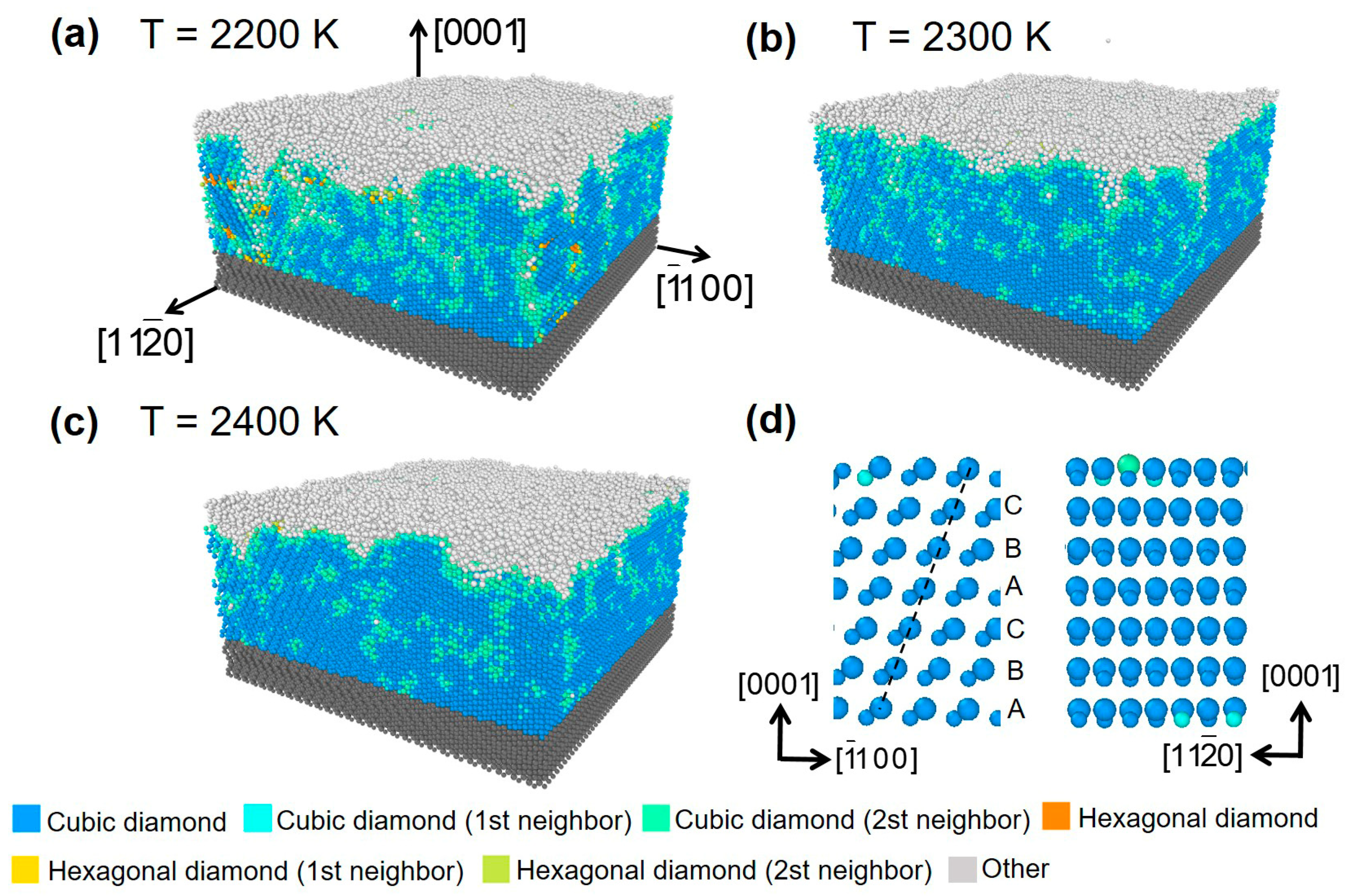
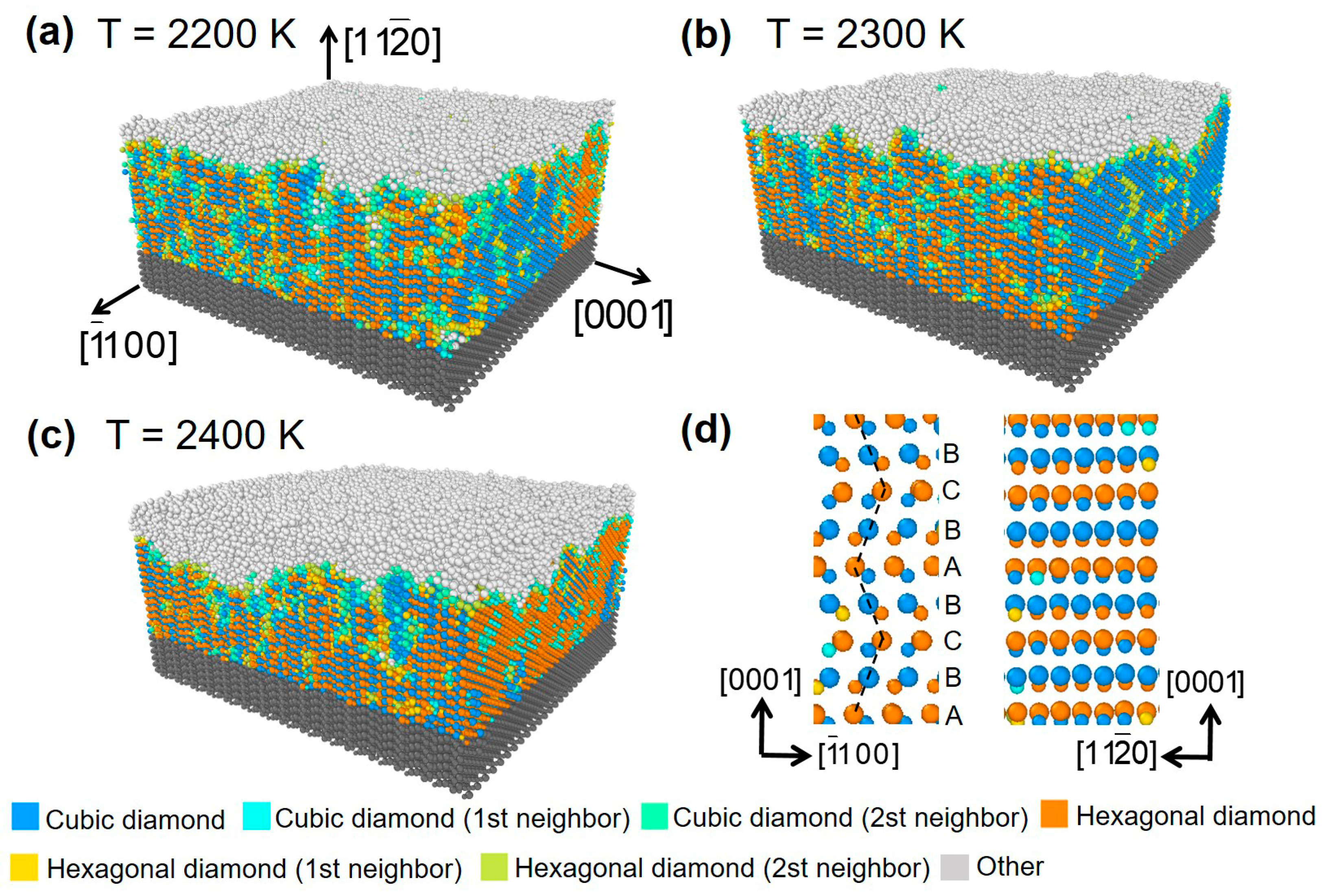
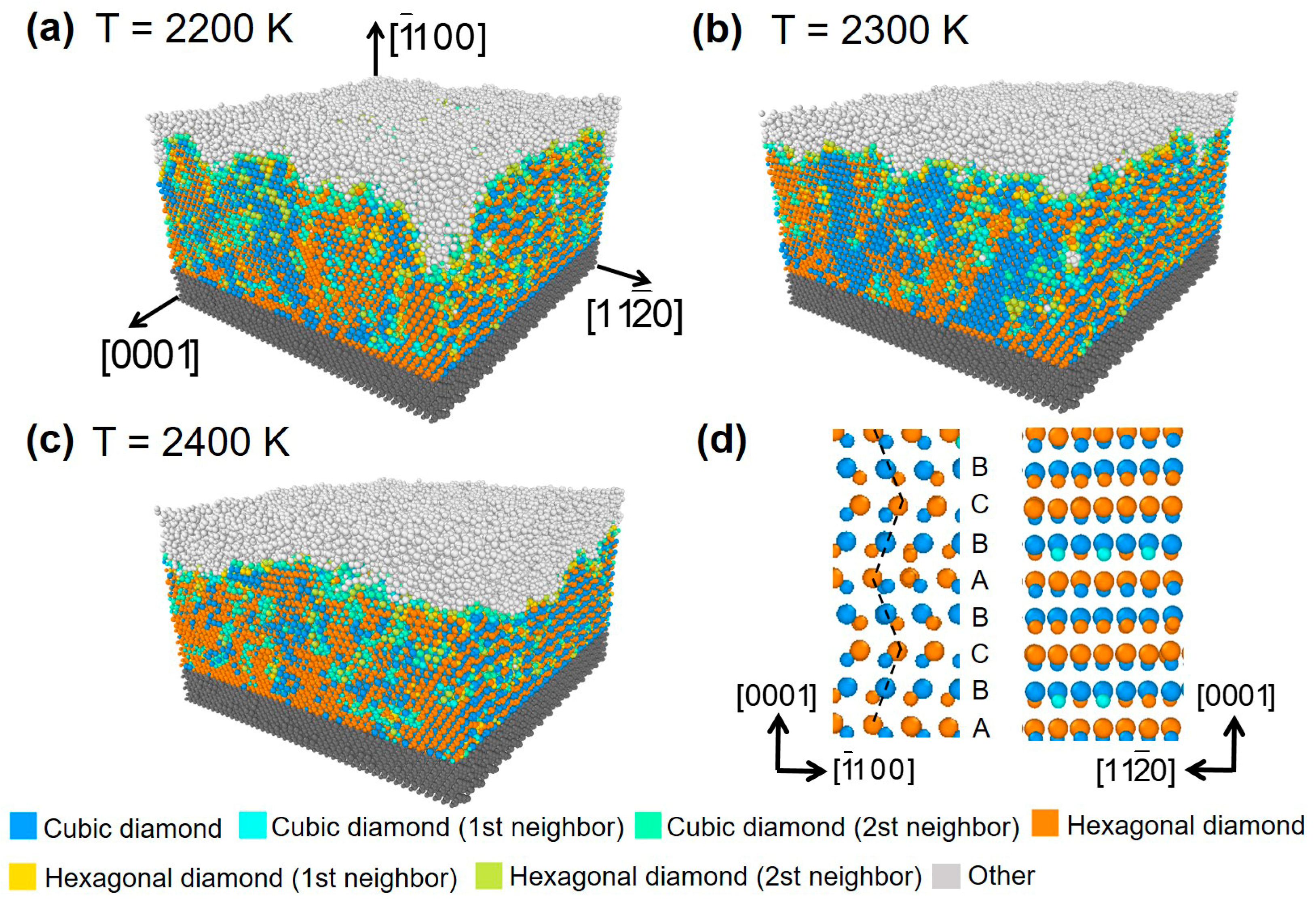
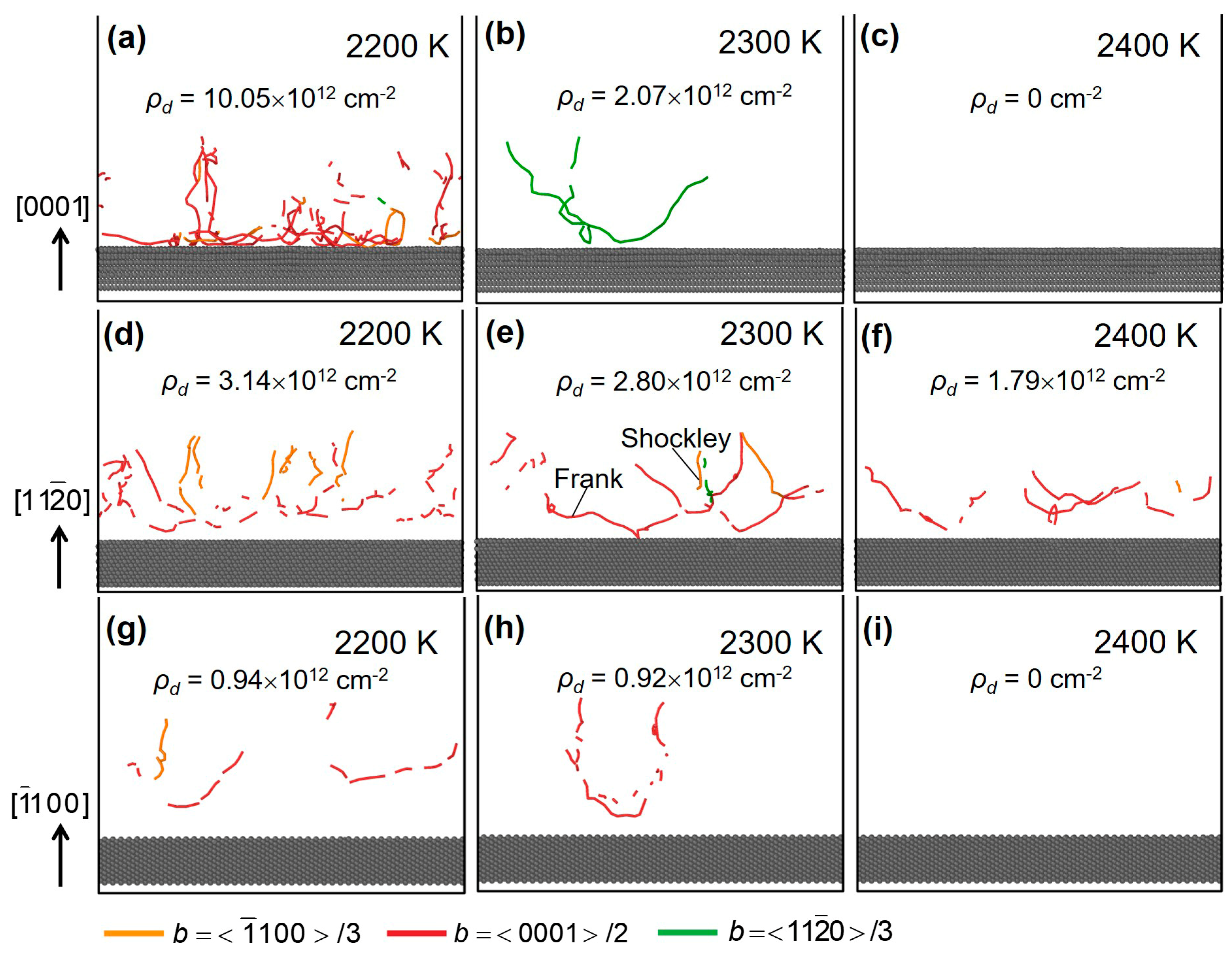

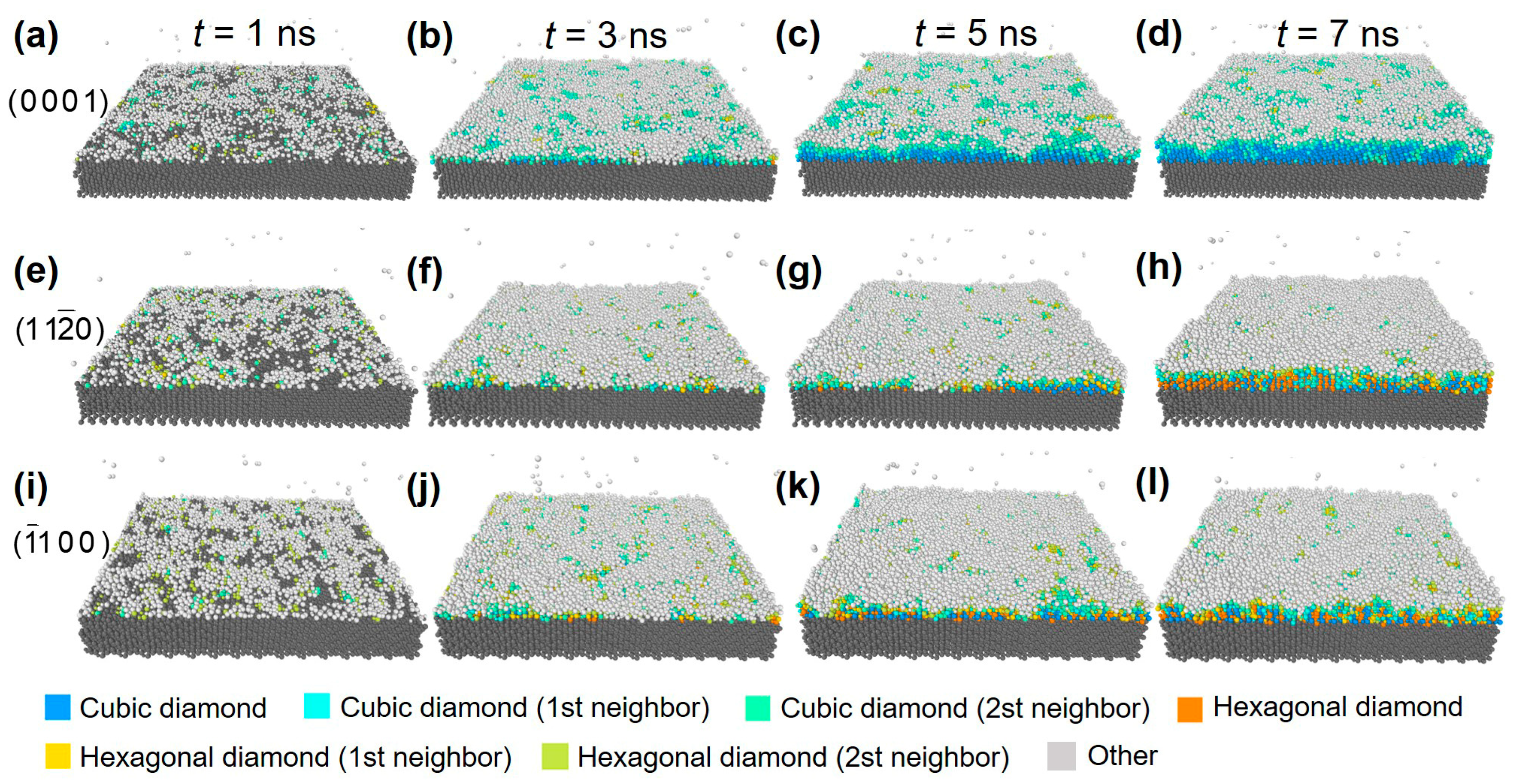
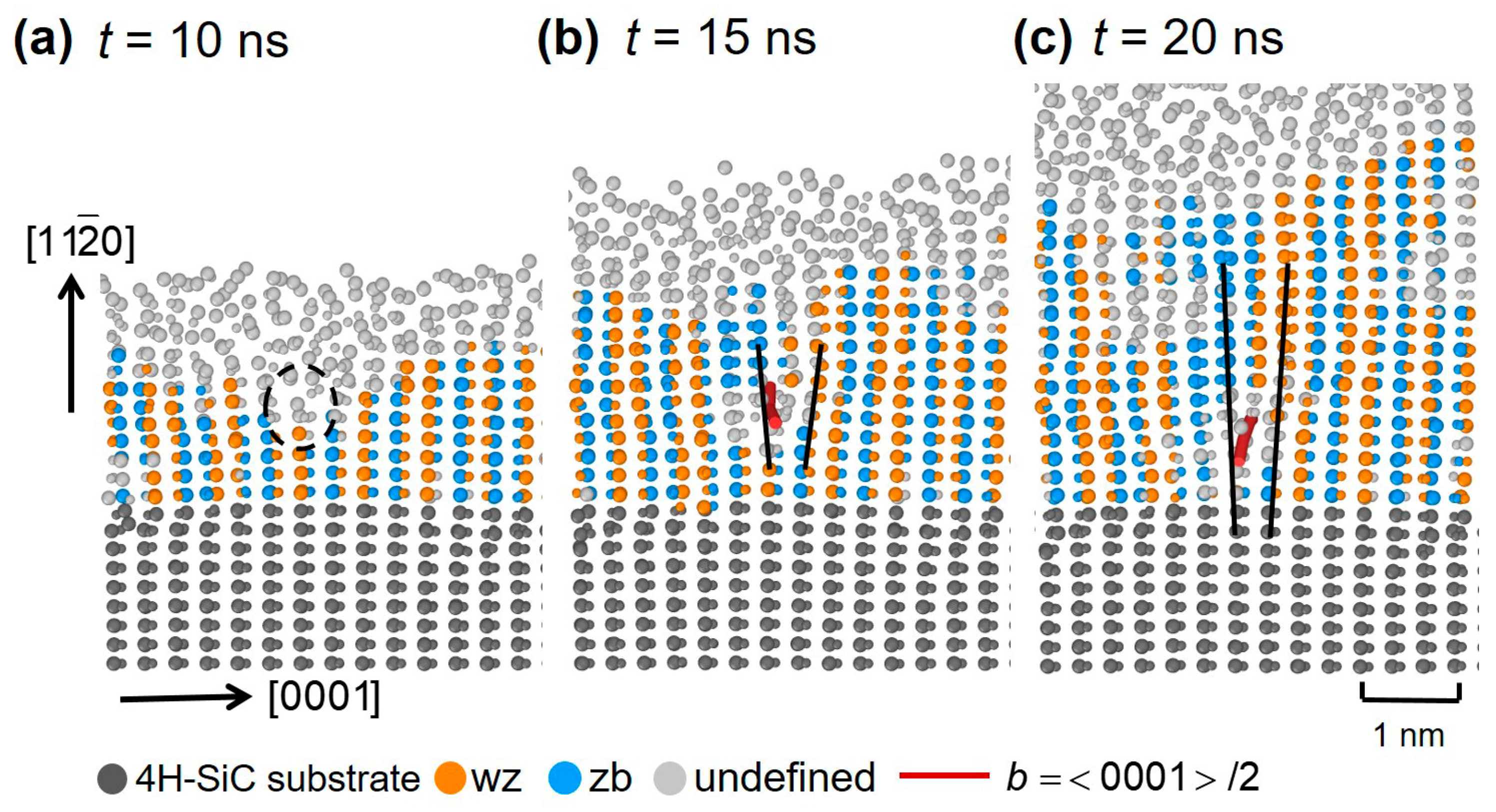
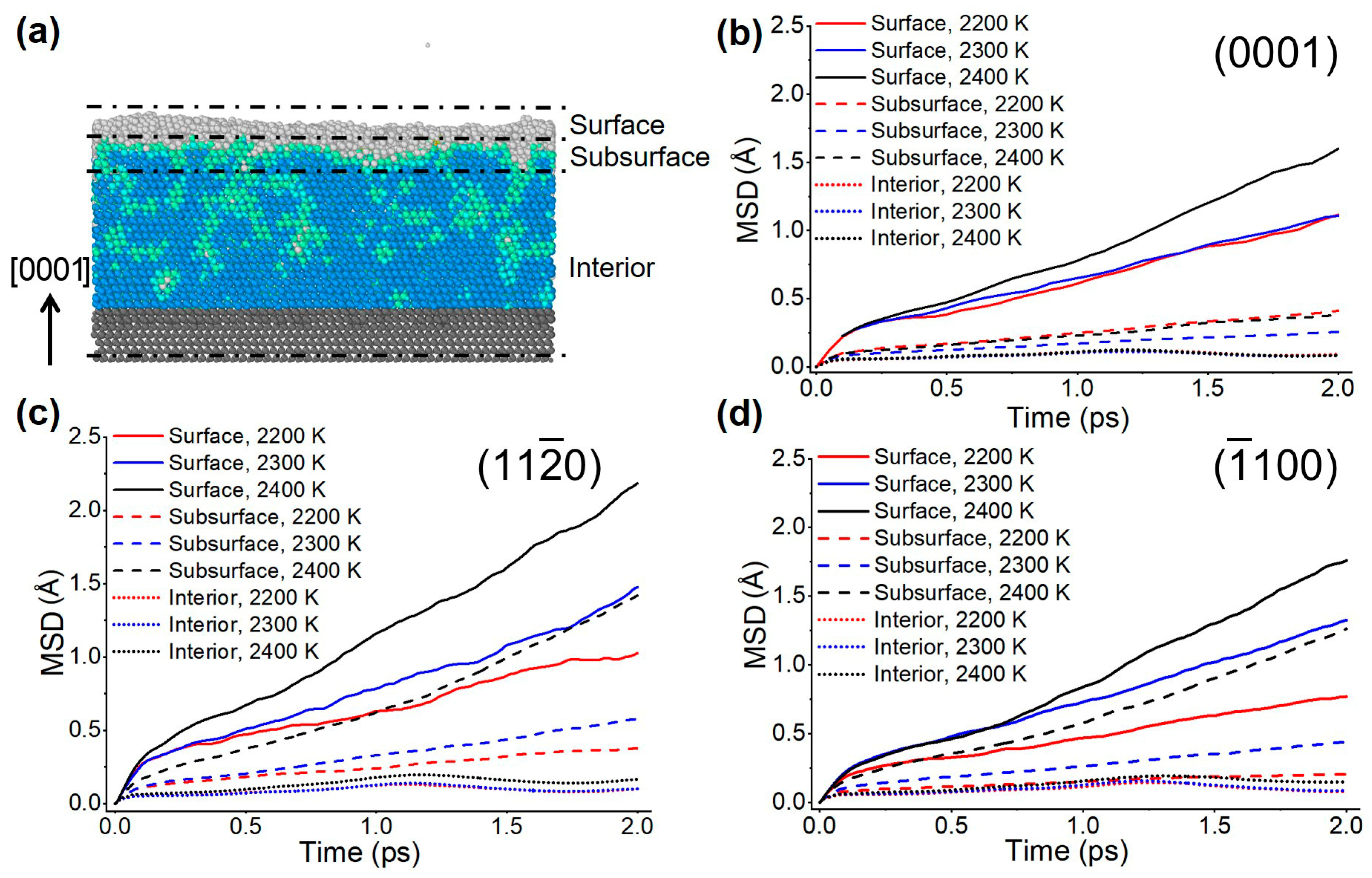
Disclaimer/Publisher’s Note: The statements, opinions and data contained in all publications are solely those of the individual author(s) and contributor(s) and not of MDPI and/or the editor(s). MDPI and/or the editor(s) disclaim responsibility for any injury to people or property resulting from any ideas, methods, instructions or products referred to in the content. |
© 2023 by the authors. Licensee MDPI, Basel, Switzerland. This article is an open access article distributed under the terms and conditions of the Creative Commons Attribution (CC BY) license (https://creativecommons.org/licenses/by/4.0/).
Share and Cite
Wu, K.; Mei, Q.; Liu, H.; Zhou, S.; Gao, B.; Li, C.; Liu, S.; Wan, L. Vapor Deposition Growth of SiC Crystal on 4H-SiC Substrate by Molecular Dynamics Simulation. Crystals 2023, 13, 715. https://doi.org/10.3390/cryst13050715
Wu K, Mei Q, Liu H, Zhou S, Gao B, Li C, Liu S, Wan L. Vapor Deposition Growth of SiC Crystal on 4H-SiC Substrate by Molecular Dynamics Simulation. Crystals. 2023; 13(5):715. https://doi.org/10.3390/cryst13050715
Chicago/Turabian StyleWu, Kangli, Qingsong Mei, Haowen Liu, Shengjun Zhou, Bing Gao, Chenglin Li, Sheng Liu, and Liang Wan. 2023. "Vapor Deposition Growth of SiC Crystal on 4H-SiC Substrate by Molecular Dynamics Simulation" Crystals 13, no. 5: 715. https://doi.org/10.3390/cryst13050715
APA StyleWu, K., Mei, Q., Liu, H., Zhou, S., Gao, B., Li, C., Liu, S., & Wan, L. (2023). Vapor Deposition Growth of SiC Crystal on 4H-SiC Substrate by Molecular Dynamics Simulation. Crystals, 13(5), 715. https://doi.org/10.3390/cryst13050715







